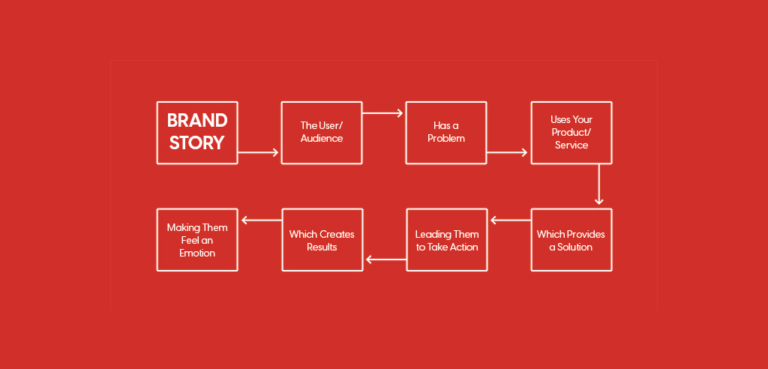- Blog
How to tell a brand’s story: Copywriting and the importance of storytelling
As marketers, we are constantly looking for new strategies to grab people’s attention and motivate them to take action. Most likely, you’ve already tried the standard suspects like fear, shock, and hurry. All of these strategies work with a potential new consumer, but soon you’ll need a different tactic to keep them coming back.
That’s where storytelling comes into play. Content marketing’s steady adoption of storytelling is an exciting new opportunity for content creators. The human brain is wired to respond to well-crafted narrative; neuroscience proves that storytelling is the best way to capture people’s attention, bake information into their memories, and forge close, personal bonds. Your audience is programmed to crave and seek out great stories; that’ll never change.
In today’s crowded marketplace, it’s more important than ever to have a compelling brand story that resonates with your audience. Your brand story is more than just the products or services you offer. It’s the heart and soul of your business, the reason why you exist, and the values that drive your decisions.
So, how do you tell your brand’s story in a way that connects with your customers and sets you apart from the competition? That’s where copywriting and storytelling come in.
What is storytelling in marketing?
Brand storytelling is the cohesive narrative that weaves together the facts and emotions that your brand evokes.” – Forbes
A brand story recounts the chain of events that led to the start of your company and how that story still drives your mission today. Just like your favourite book and movie characters, if you can craft a compelling brand story, your audience will remember who you are, develop empathy for you, and, ultimately, care about you.
A brand story outlines the how and why of your company’s beginnings and in what ways those elements drive your brand mission today.
Brand storytelling is a key relationship-building tool and can be subtle while still powerfully guiding the concept of your overarching web presence. Your story should be a look into who you are as a business and be something that you — and your entire team — embrace passionately.
And even though it appears to be a good story about your company — it’s really about your customers and the value you offer them. They are the real stars of your story. Your brand is the supporting cast. The development of your approach to your brand storytelling should reflect that.

Why do brands tell stories?

Stories simplify complex concepts
Some products are more complex than others, but even those that aren’t can be challenging to explain succinctly, clearly, and in a way that appeals to end customers. However, stories eliminate each. They ignore the technical jargon and focus on the information that matters most: how it benefits the audience.
Stories inspire action
Because you work with it every day, you are aware of how fantastic your product is, how easy it is to use, and how much easier it will make your market’s daily life. However, customers are not. They won’t fully comprehend the significance or the advantages unless they have experienced them for themselves, therefore storytelling is the next best option. You may persuade folks to take that crucial initial step by illustrating what the future might hold. Always keep in mind that storytelling is about your consumer and what they gain from working with you rather than about your business or product.
It conveys your brand personality
Brand personality is the set of human values and traits that your brand exemplifies. This is “who” your clients are speaking with when they interact with your business. You can stand out in any business with a strong brand story. You develop into a buddy rather than just a business. This engages potential customers with your brand and converts them into devoted patrons who feel at home.
The Components of Great Brand Stories
It is obvious that your brand story is going to differ from that of other businesses, which is essential for making your business unique. However, all great brand stories have some things in common. Let us dig into that. Persuasive and captivating brand stories are:
1. Meaningful
Brand stories should not be misinterpreted as some whimsical narrative to pique your audience’s interest. Every brand story serves a specific purpose and clearly communicates what your brand has to offer. As a result, make sure you create a story that somehow relates to your target audience, has the potential to persuade them, and motivates them to act.
2. Personal
If you can connect with your audience on a personal level, your brand story will become great and captivating. As a result, it is critical to create real, relatable characters in your story with whom they can identify and resonate. Your company is run by real people, not robots behind a screen. Allow your brand’s personality to drive its story.
3. Emotional
Great stories are not just meant to be seen. They should make the audience feel the emotions conveyed. When you tell an emotional story to your target audience, you create a deeper level of engagement that goes beyond just selling your products/services. This way, you can foster empathy, trust and loyalty to your brand. You can incorporate elements like humor, nostalgia, inspiration, or empathy. Try to invade their hearts with an overwhelming story and stand out from the crowd.
4. Simple
Not everyone in your audience will be tech savvy. As a result, it is critical to write stories in a simple language free of jargon. Make an effort to convey the message in a conversational and engaging tone.
5. Authentic
What your brand needs is genuine connections. You want your audience to be a apart of your story, not just a passive listener. Thus, your story needs to be honest, and should reflect the values and beliefs of your brand. When your audience feels that your brand story is authentic, they are more likely to trust and engage with your brand.
Try to make your story unpretentious as possible. That way you can engage with your audience in a better way.
How to Tell Your Brand’s Story
Now, let’s get into the nitty gritty — the all-important how of telling your brand’s story. How do you create a compelling story? Begin with the fundamentals.
Telling your brand story involves sharing the history, values, and unique characteristics that make your brand stand out. Here are some things to keep in mind:
Start with the “why”: Begin by explaining why you started your brand or company. What inspired you to create it? What problem were you trying to solve?
Emphasize your values: Share the values that your company is committed to. These might include things like sustainability, innovation, quality, or customer service.
Share your milestones: Talk about the major milestones that your brand has achieved over the years. These might include launching a new product line, expanding into new markets, or winning awards.
Make it personal: Share personal anecdotes or stories that illustrate your brand’s journey. This can help you connect emotionally with your audience
Be authentic: Above all, be authentic and true to your brand’s personality. Your brand story should reflect the essence of your brand and resonate with your audience.
By combining these elements, you can create a compelling brand story that will help your audience connect with your brand on a deeper level.
Using Copywriting and Storytelling
So, how can you use copywriting and storytelling to tell your brand’s story? Here are some tips:
Identify your brand’s unique value proposition. What makes your brand different from your competitors? What problem are you solving, and why are you the best solution?
Develop a brand persona. Who is your ideal customer? What are their pain points, desires, and goals? Develop a clear picture of your customer so that you can craft messages that resonate with them.
Use the power of emotion. People make decisions based on emotion, not logic. Use storytelling to create an emotional connection with your audience. Share your brand’s origin story, highlight your values, and showcase your customers’ success stories.
Keep it simple. Your brand story should be easy to understand and remember. Avoid jargon, technical terms, and complex explanations.
Use a consistent voice and tone. Your brand’s voice and tone should be consistent across all your marketing channels. Whether you’re writing a blog post, a social media update, or an email, your brand’s personality should shine through.
- Focus on benefits, not features. Your customers care about how your product or service can help them, not the features themselves. Highlight the benefits of your offering and show how they can solve your customers’ problems.
What is your brand’s story?
With story-based marketing, you can reach out to your ideal clientele right away, help them through their challenges and onto success, and demonstrate your values to them.
Everyone has a story
If you are struggling to find yours, maybe we can help!
